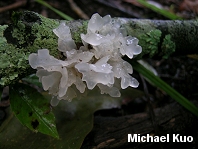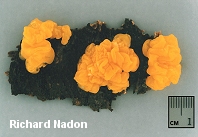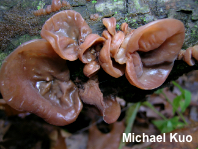| Major Groups > Jelly Fungi |

|
Jelly Fungi [ Basidiomycota . . . ] by Michael Kuo The jelly fungi are diverse and complicated, belonging to several groups within the phylum Basidiomycota. Identification of species often hinges on microscopic examination, and things are further complicated by the fact that it is often difficult to transport a jelly fungus home in "examinable" condition, to say nothing of the difficulties encountered with trying to dry and preserve specimens. For now, anyway, I provide only a cursory treatment of the jelly fungi; the pages linked below represent some commonly encountered species. A list of references is provided below for those who want to pursue jelly fungus identification further. Ascocoryne sarcoides (jelly-like Ascomycete) |
|
|
References Alvarenga, L. M. & S. Xavier-Santos (2017). New records of Dacrymycetes (Fungi: Basidiomycota) from the Cerrado Biome (Brazilian Savanna) and Midwest Region, Brazil. Check List 13: 335–342. Bandoni, R. J. & G. C. Hughes (1984). A new Dacrymyces from British Columbia. Mycologia 76: 63–66. Bandoni, R. J. (1987). Taxonomic overview of the Tremellales. Studies in Mycology 30: 87–110. Bandoni, R. & J. Ginns (1998). Notes on Tremella mesenterica and allied species. Canadian Journal of Botany 76: 1544–1557. Berres, M. E., L. J. Szabo & D. J. McLaughlin (1995). Phylogenetic relationships in auriculariaceous basidiomycetes based on 25S ribosomal DNA sequences. Mycologia 87: 821–840. Bodman, M. C. (1942). The genus Tremellodendron. The American Midland Naturalist 27: 203–216. Brasfield, T. W. (1938). The Dacrymycetaceae of temperate North America. The American Midland Naturalist 20: 211–235. Castro-Santuiste, S., S. Sierra, L. Guzmán-Dávalos & I. Luna-Vega (2017). A review of the taxonomy and species diversity in Dacrymycetes (Fungi, Basidiomycota) in Mexico. Nova Hedwigia 105: 365–384. Castro-Santiuste, S., S. Sierra, L. Guzmán-Dávalos, J. Cifuentes, T. Evans, C. R. Martínez-González, H. Alvarado-Sizzo & I. Luna-Vega (2020). Dacryopinax (Fungi: Dacrymycetales) in Mexico. Phytotaxa 446: 006–022. Chen, C.-J. (1998). Morphological and molecular studies in the genus Tremella. Germany: J. Cramer, 225 pp. Duncan, E. G. & J. A. Macdonald (1967). Micro-evolution in Auricularia auricula. Mycologia 59: 803–818. Ginns, J. (1986). The genus Syzygospora (Heterobasidiomycetes: Syzygosporaceae. Mycologia 78: 619–636. Kennedy, L. L. (1958). The genus Dacrymyces. Mycologia 50: 896–915. Kennedy, L. L. (1964). The genus Ditiola. Mycologia 56: 298–308. Liu, X. -Z., Q. -M. Wang, M. Göker, M. Groenewald, A. V. Kachalkin, H. T. Lumbsch, A. M. Millanes, M. Wedin, A. M. Yurkov, T. Boekhout & F. -Y. Bai (2016). Towards an integrated phylogenetic classification of the Tremellomycetes. Studies in Mycology 81: 85–147. Looney, B. P., J. M. Birkebak & P. B. Matheny (2013). Systematics of the genus Auricularia with an emphasis on species from the southeastern United States. North American Fungi 8: 1–25. Lowy, B. (1952). The genus Auricularia. Mycologia 44: 656–692. Lowy, B. (1971). Flora neotropica. Monograph no. 6. Tremellales. New York: Hafner Publishing Company. 153 pp. Lowy, B. (1980). Flora neotropica. Monograph no. 6 (supplement). Tremellales. New York: The New York Botanical Garden. 18 pp. Martin, G. W. (1932). On certain species of Heterotextus. Mycologia 24: 215–220. Martin, G. W. (1952). Revision of the north central Tremellales. Studies in Natural History at Iowa University 19: 1–112. McNabb, R. F. R. (1965). Taxonomic studies on the Dacrymycetaceae II. Calocera (Fries) Fries. New Zealand Journal of Botany 3: 21–58. McNabb, R. F. R. (1965). Taxonomic studies on the Dacrymycetaceae III. Dacryopinax Martin. New Zealand Journal of Botany 3: 59–72. McNabb, R. F. R. (1965). Taxonomic studies on the Dacrymycetaceae VI. Femsjonia Fries. New Zealand Journal of Botany 3: 223–228. McNabb, R. F. R. (1973). Taxonomic studies on the Dacrymycetaceae VIII. Dacrymyces Nees ex Fries. New Zealand Journal of Botany 11: 461–524. Millanes, A. M., P. Diederich, S. Ekman & M. Wedin (2011). Phylogeny and character evolution in the jelly fungi (Tremellomycetes, Basidiomycota, Fungi). Molecular Phylogenetics and Evolution 61: 12–28. Oberwinkler, F., K. Riess, R. Bauer & S. Garnica (2014). Morphology and molecules: the Sebacinales, a case study. Mycological Progress 13: 445–470. Olive, L. S. (1946). Some taxonomic notes on the higher fungi. Mycologia 38: 534–547. Olive, L. S. (1947). Notes on the Tremellales of Georgia. Mycologia 39: 90–108. Olive, L. S. (1948). Notes on Louisiana fungi. II. Tremellales. Mycologia 40: 586–604. Olive, L. S. (1950). A new genus of the Tremellales from Louisiana. Mycologia 42: 385–390. Olive, L. S. (1951a). Notes on Louisiana fungi. III. Additions to the Tremellales. Mycologia 43: 677–690. Olive, L. S. (1951b). New or noteworthy species of Tremellales from the southern Appalachians. Bulletin of the Torrey Botanical Club 78: 103–112. Olive, L. S. (1953). New or noteworthy species of Tremellales from the southern Appalachians—II. Bulletin of the Torrey Botanical Club 80: 33–42. Olive, L. S. (1954). New or noteworthy species of Tremellales from the southern Appalachians—III. Bulletin of the Torrey Botanical Club 81: 329–339. Overall, A. (2017). Tremella aurantia & T. mesenterica, two British "Yellow Brain Fungi" compared. Field Mycology 18: 82–84. Raymundo, T., M. Contreras, S. Bautista-Hernández, R. Díaz-Moreno & R. Valenzuela (2012). Hongos tremeloides del Bosque Las Bayas, Municipio de Pueblo Nuevo, Durango, México. Polibotánica 33: 85–103. Reid, D. A. (1974). A monograph of the British Dacrymycetales. Transactions of the British Mycological Society 62: 433–494. Reid, D. A. (1983). Notes on Dacrymycetales. Transactions of the British Mycological Society 80: 483–486. Roberts, P. (1995). British Tremella species I: Tremella aurantia & T. mesenterica. Mycologist 9: 110–114. Seifert, K. A. (1983). Decay of wood by the Dacrymycetales. Mycologia 75: 1011–1018. Shirouzu, T., D. Hirose, F. Oberwinkler, N. Shimomura, N. Maekawa & S. Tokumasu (2013). Combined molecular and morphological data for improving phylogenetic hypothesis in Dacrymycetes. Mycologia 105: 1110–1125. Sierra, S. & J. Cifuentes (2005). A new species of Dacryopinax from Mexico. Mycotaxon 92: 243–250. Spirin, V., V. Malysheva, A. Yurkov, O. Miettinen & K. -H. Larsson (2018). Studies in the Phaeotremella foliacea group (Tremellomycetes, Basidiomycota). Mycological Progress 17: 451–466. Torkelsen, A. E. (1968). The genus Tremella in Norway. Nytt. Mag. Bot. 15: 229–232. Walker, J. F. & J. L. Parrent (2004). Molecular phylogenetic evidence for the mycorrhizal status of Tremellodendron (Sebacinaceae). In Cripps, C. L., ed.: Fungi in forest ecosystems: Systematics, diversity, and ecology. (Memoirs of the New York Botanical Garden 89.) Bronx: The New York Botanical Garden Press. Wedin, M., J. C. Zamora & A. M. Millanes (2016). Phaeotremella foliacea comb. nov. (Tremellales, Tremellomycetes, Agaricomycotina). Mycosphere 7: 295-296. Wells, K. (1958). Studies of some Tremellaceae. II. The genus Ductifera. Mycologia 50: 407–416. Wells, K. (1994). Jelly fungi, then and now. Mycologia 86: 18–48. Wong, G. J., K. Wells & R. J. Bandoni (1985). Interfertility and comparative morphological studies of Tremella mesenterica. Mycologia 77: 36–49. Wong, J. G. (1993). Mating and fruiting studies of Auricularia delicata and A. fuscosuccinea. Mycologia 85: 187–194. Wu, F., Y. Yuan, S. -H. He, A. R. Bandara, K. D. Hyde, V. F. Malysheva, D. -W. Li & Y. -C. Dai (2015). Global diversity and taxonomy of the Auricularia auricula-judae complex (Auriculariales, Basidiomycota). Mycological Progress 14: 95. Zamora, J. C. & S. Ekman (2020). Phylogeny and character evolution in the Dacrymycetes, and systematics of Unilacrymaceae and Dacryonaemataceae fam. nov. Persoonia 44: 161–205. Zugmaier, W. et al. (1994). Mycoparasitism of some Tremella species. Mycologia 86: 49–56. This website contains no information about the edibility or toxicity of mushrooms. Cite this page as: Kuo, M. (2008, November). Jelly fungi. Retrieved from the MushroomExpert.Com Web site: http://www.mushroomexpert.com/jellies.html © MushroomExpert.Com |


